MNG82001 Organisational Behaviour: Employee Engagement Review
VerifiedAdded on 2023/06/12
|7
|1798
|265
Literature Review
AI Summary
This literature review delves into the concept of employee engagement, defining it as a process by which organizations enhance employee involvement to improve individual and overall performance. It highlights the benefits of employee engagement, including enhanced individual performance, a more positive work environment, and increased bonding among employees. Various employee engagement activities, such as fun activities, recreational programs like yoga, and yearly events, are discussed as means to reduce stress and increase workplace engagement. The review also notes a gap in the literature, as limited research has been conducted on employee engagement compared to other management topics. It concludes that employee engagement is a crucial aspect of modern business, requiring further research to maximize its effectiveness in enhancing employee participation and performance.
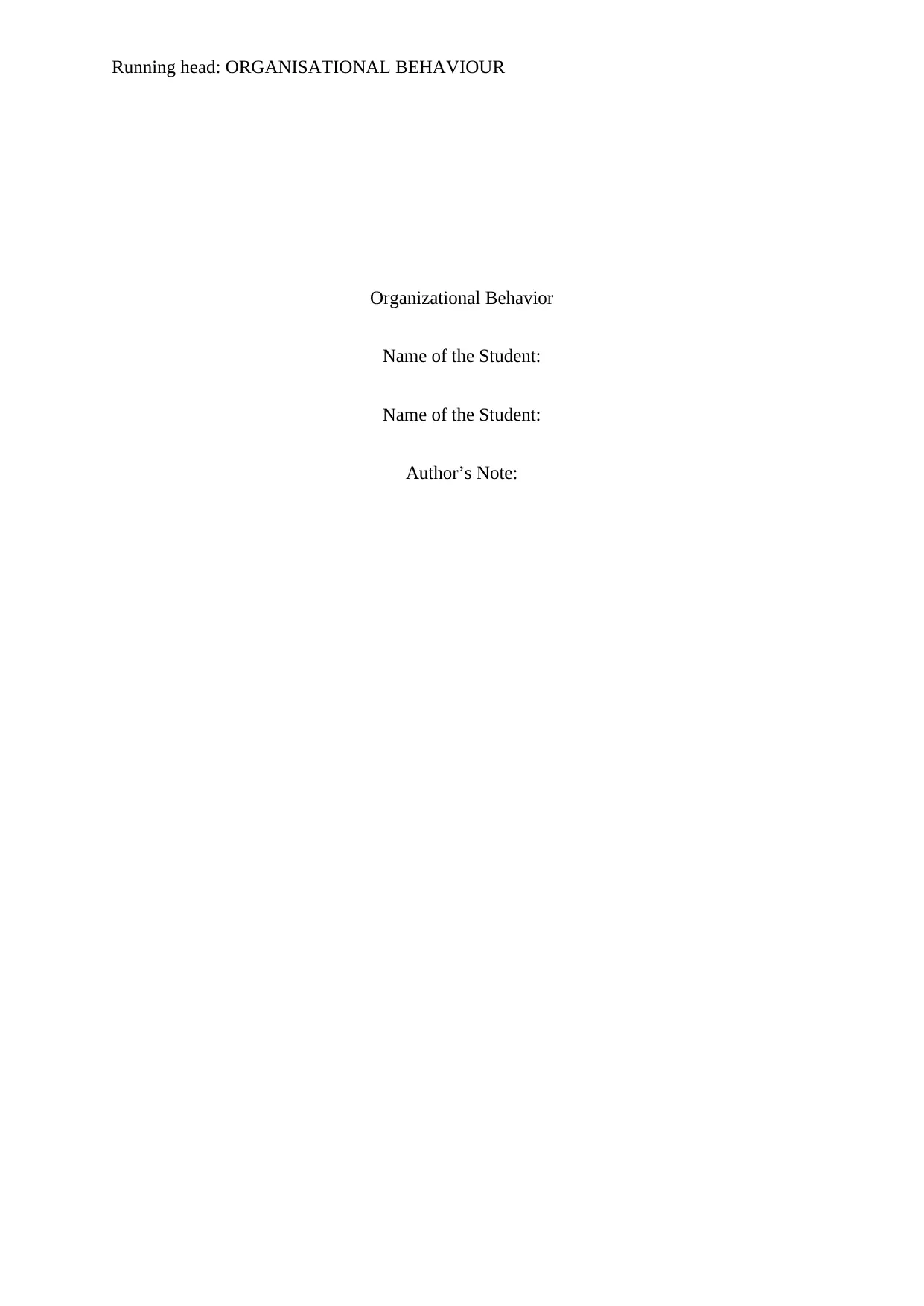
Running head: ORGANISATIONAL BEHAVIOUR
Organizational Behavior
Name of the Student:
Name of the Student:
Author’s Note:
Organizational Behavior
Name of the Student:
Name of the Student:
Author’s Note:
Paraphrase This Document
Need a fresh take? Get an instant paraphrase of this document with our AI Paraphraser
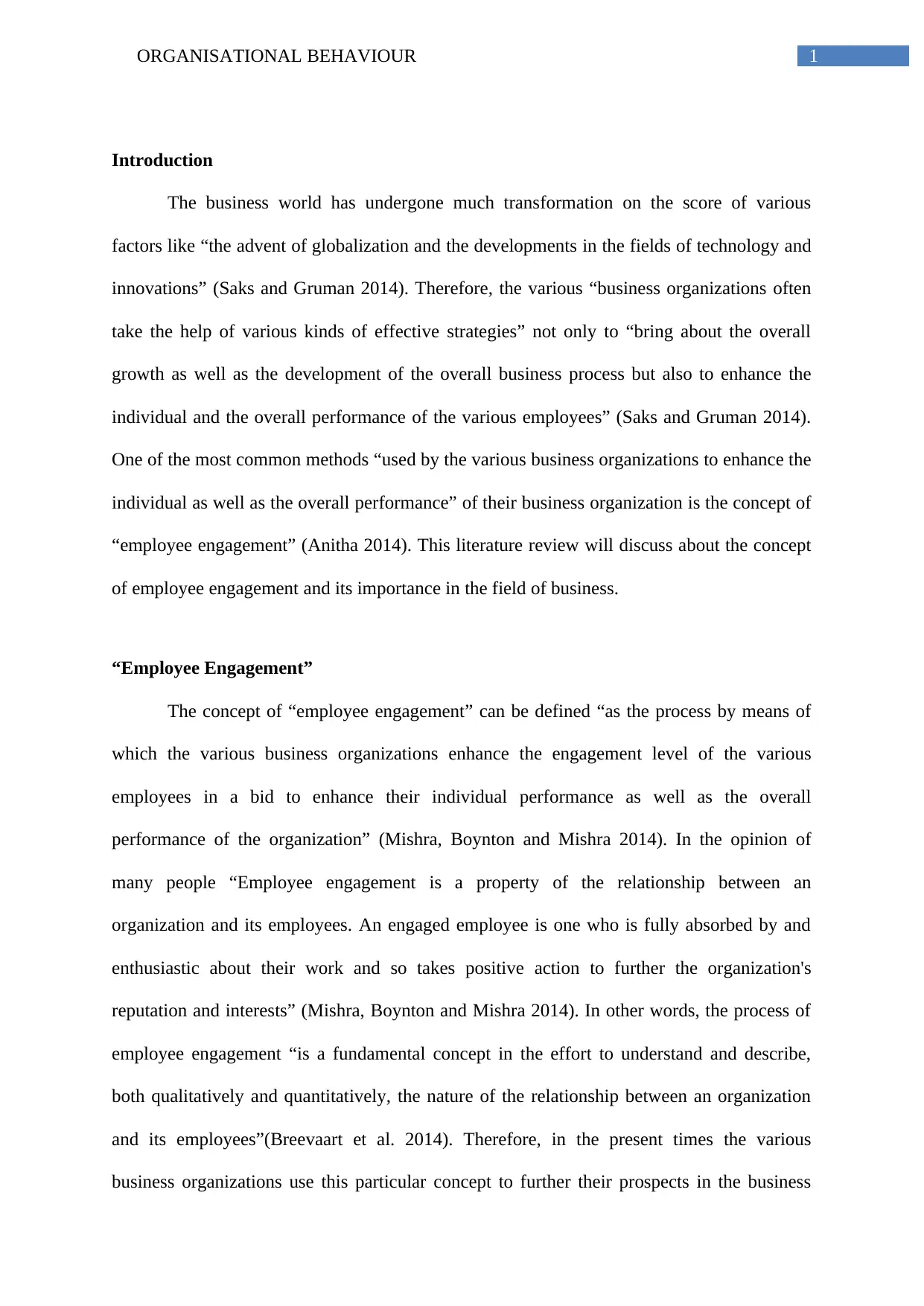
1ORGANISATIONAL BEHAVIOUR
Introduction
The business world has undergone much transformation on the score of various
factors like “the advent of globalization and the developments in the fields of technology and
innovations” (Saks and Gruman 2014). Therefore, the various “business organizations often
take the help of various kinds of effective strategies” not only to “bring about the overall
growth as well as the development of the overall business process but also to enhance the
individual and the overall performance of the various employees” (Saks and Gruman 2014).
One of the most common methods “used by the various business organizations to enhance the
individual as well as the overall performance” of their business organization is the concept of
“employee engagement” (Anitha 2014). This literature review will discuss about the concept
of employee engagement and its importance in the field of business.
“Employee Engagement”
The concept of “employee engagement” can be defined “as the process by means of
which the various business organizations enhance the engagement level of the various
employees in a bid to enhance their individual performance as well as the overall
performance of the organization” (Mishra, Boynton and Mishra 2014). In the opinion of
many people “Employee engagement is a property of the relationship between an
organization and its employees. An engaged employee is one who is fully absorbed by and
enthusiastic about their work and so takes positive action to further the organization's
reputation and interests” (Mishra, Boynton and Mishra 2014). In other words, the process of
employee engagement “is a fundamental concept in the effort to understand and describe,
both qualitatively and quantitatively, the nature of the relationship between an organization
and its employees”(Breevaart et al. 2014). Therefore, in the present times the various
business organizations use this particular concept to further their prospects in the business
Introduction
The business world has undergone much transformation on the score of various
factors like “the advent of globalization and the developments in the fields of technology and
innovations” (Saks and Gruman 2014). Therefore, the various “business organizations often
take the help of various kinds of effective strategies” not only to “bring about the overall
growth as well as the development of the overall business process but also to enhance the
individual and the overall performance of the various employees” (Saks and Gruman 2014).
One of the most common methods “used by the various business organizations to enhance the
individual as well as the overall performance” of their business organization is the concept of
“employee engagement” (Anitha 2014). This literature review will discuss about the concept
of employee engagement and its importance in the field of business.
“Employee Engagement”
The concept of “employee engagement” can be defined “as the process by means of
which the various business organizations enhance the engagement level of the various
employees in a bid to enhance their individual performance as well as the overall
performance of the organization” (Mishra, Boynton and Mishra 2014). In the opinion of
many people “Employee engagement is a property of the relationship between an
organization and its employees. An engaged employee is one who is fully absorbed by and
enthusiastic about their work and so takes positive action to further the organization's
reputation and interests” (Mishra, Boynton and Mishra 2014). In other words, the process of
employee engagement “is a fundamental concept in the effort to understand and describe,
both qualitatively and quantitatively, the nature of the relationship between an organization
and its employees”(Breevaart et al. 2014). Therefore, in the present times the various
business organizations use this particular concept to further their prospects in the business
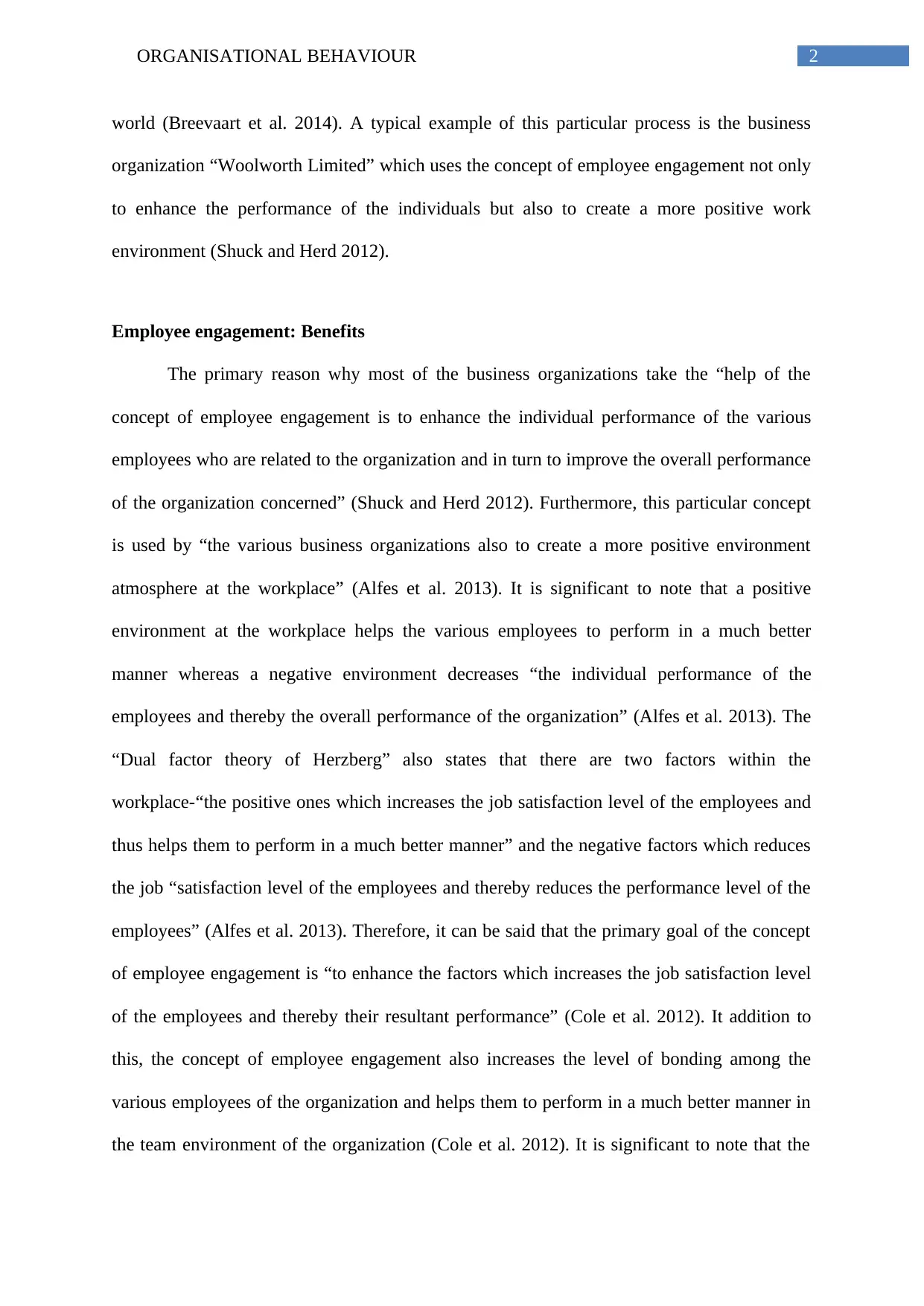
2ORGANISATIONAL BEHAVIOUR
world (Breevaart et al. 2014). A typical example of this particular process is the business
organization “Woolworth Limited” which uses the concept of employee engagement not only
to enhance the performance of the individuals but also to create a more positive work
environment (Shuck and Herd 2012).
Employee engagement: Benefits
The primary reason why most of the business organizations take the “help of the
concept of employee engagement is to enhance the individual performance of the various
employees who are related to the organization and in turn to improve the overall performance
of the organization concerned” (Shuck and Herd 2012). Furthermore, this particular concept
is used by “the various business organizations also to create a more positive environment
atmosphere at the workplace” (Alfes et al. 2013). It is significant to note that a positive
environment at the workplace helps the various employees to perform in a much better
manner whereas a negative environment decreases “the individual performance of the
employees and thereby the overall performance of the organization” (Alfes et al. 2013). The
“Dual factor theory of Herzberg” also states that there are two factors within the
workplace-“the positive ones which increases the job satisfaction level of the employees and
thus helps them to perform in a much better manner” and the negative factors which reduces
the job “satisfaction level of the employees and thereby reduces the performance level of the
employees” (Alfes et al. 2013). Therefore, it can be said that the primary goal of the concept
of employee engagement is “to enhance the factors which increases the job satisfaction level
of the employees and thereby their resultant performance” (Cole et al. 2012). It addition to
this, the concept of employee engagement also increases the level of bonding among the
various employees of the organization and helps them to perform in a much better manner in
the team environment of the organization (Cole et al. 2012). It is significant to note that the
world (Breevaart et al. 2014). A typical example of this particular process is the business
organization “Woolworth Limited” which uses the concept of employee engagement not only
to enhance the performance of the individuals but also to create a more positive work
environment (Shuck and Herd 2012).
Employee engagement: Benefits
The primary reason why most of the business organizations take the “help of the
concept of employee engagement is to enhance the individual performance of the various
employees who are related to the organization and in turn to improve the overall performance
of the organization concerned” (Shuck and Herd 2012). Furthermore, this particular concept
is used by “the various business organizations also to create a more positive environment
atmosphere at the workplace” (Alfes et al. 2013). It is significant to note that a positive
environment at the workplace helps the various employees to perform in a much better
manner whereas a negative environment decreases “the individual performance of the
employees and thereby the overall performance of the organization” (Alfes et al. 2013). The
“Dual factor theory of Herzberg” also states that there are two factors within the
workplace-“the positive ones which increases the job satisfaction level of the employees and
thus helps them to perform in a much better manner” and the negative factors which reduces
the job “satisfaction level of the employees and thereby reduces the performance level of the
employees” (Alfes et al. 2013). Therefore, it can be said that the primary goal of the concept
of employee engagement is “to enhance the factors which increases the job satisfaction level
of the employees and thereby their resultant performance” (Cole et al. 2012). It addition to
this, the concept of employee engagement also increases the level of bonding among the
various employees of the organization and helps them to perform in a much better manner in
the team environment of the organization (Cole et al. 2012). It is significant to note that the
⊘ This is a preview!⊘
Do you want full access?
Subscribe today to unlock all pages.

Trusted by 1+ million students worldwide
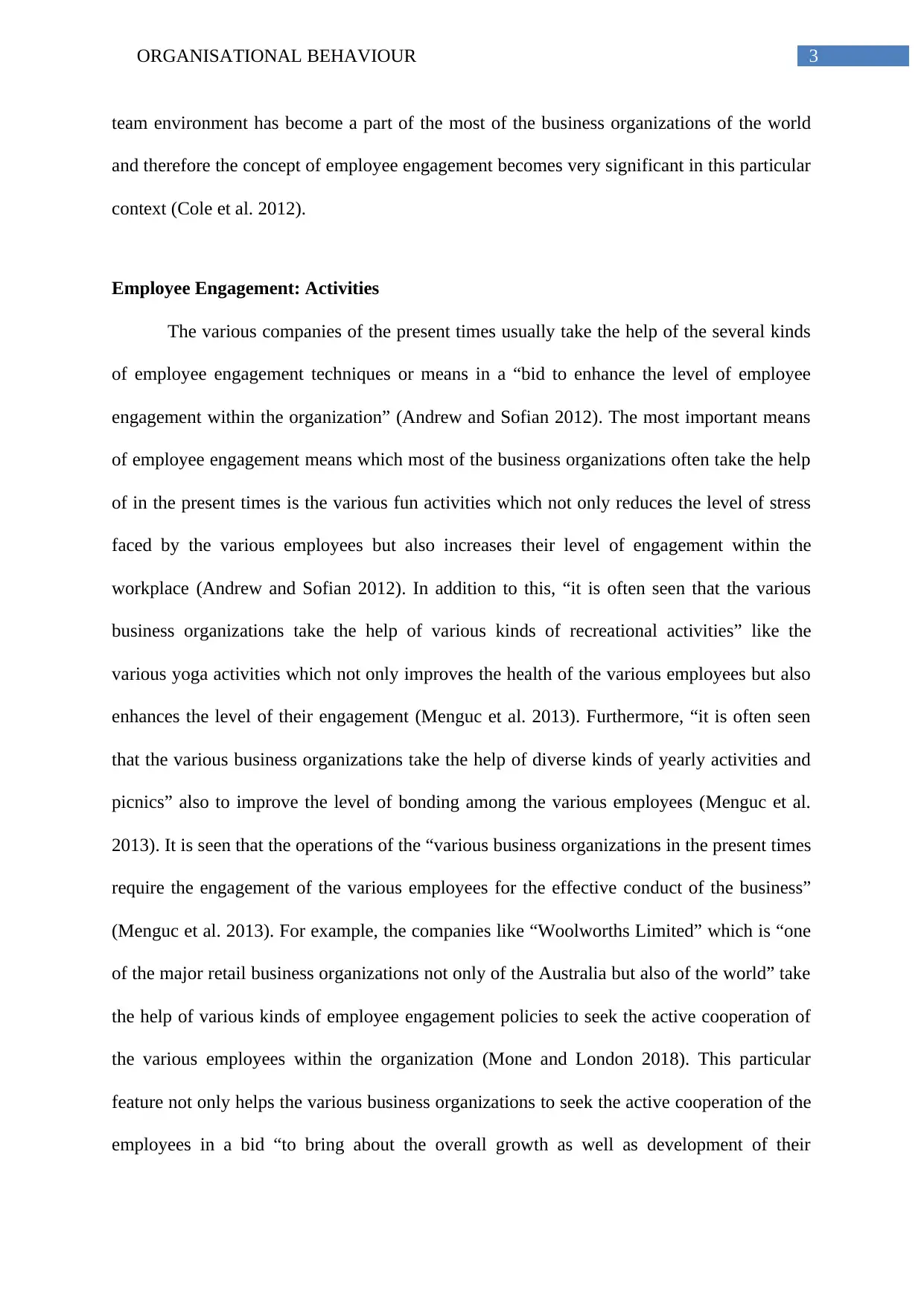
3ORGANISATIONAL BEHAVIOUR
team environment has become a part of the most of the business organizations of the world
and therefore the concept of employee engagement becomes very significant in this particular
context (Cole et al. 2012).
Employee Engagement: Activities
The various companies of the present times usually take the help of the several kinds
of employee engagement techniques or means in a “bid to enhance the level of employee
engagement within the organization” (Andrew and Sofian 2012). The most important means
of employee engagement means which most of the business organizations often take the help
of in the present times is the various fun activities which not only reduces the level of stress
faced by the various employees but also increases their level of engagement within the
workplace (Andrew and Sofian 2012). In addition to this, “it is often seen that the various
business organizations take the help of various kinds of recreational activities” like the
various yoga activities which not only improves the health of the various employees but also
enhances the level of their engagement (Menguc et al. 2013). Furthermore, “it is often seen
that the various business organizations take the help of diverse kinds of yearly activities and
picnics” also to improve the level of bonding among the various employees (Menguc et al.
2013). It is seen that the operations of the “various business organizations in the present times
require the engagement of the various employees for the effective conduct of the business”
(Menguc et al. 2013). For example, the companies like “Woolworths Limited” which is “one
of the major retail business organizations not only of the Australia but also of the world” take
the help of various kinds of employee engagement policies to seek the active cooperation of
the various employees within the organization (Mone and London 2018). This particular
feature not only helps the various business organizations to seek the active cooperation of the
employees in a bid “to bring about the overall growth as well as development of their
team environment has become a part of the most of the business organizations of the world
and therefore the concept of employee engagement becomes very significant in this particular
context (Cole et al. 2012).
Employee Engagement: Activities
The various companies of the present times usually take the help of the several kinds
of employee engagement techniques or means in a “bid to enhance the level of employee
engagement within the organization” (Andrew and Sofian 2012). The most important means
of employee engagement means which most of the business organizations often take the help
of in the present times is the various fun activities which not only reduces the level of stress
faced by the various employees but also increases their level of engagement within the
workplace (Andrew and Sofian 2012). In addition to this, “it is often seen that the various
business organizations take the help of various kinds of recreational activities” like the
various yoga activities which not only improves the health of the various employees but also
enhances the level of their engagement (Menguc et al. 2013). Furthermore, “it is often seen
that the various business organizations take the help of diverse kinds of yearly activities and
picnics” also to improve the level of bonding among the various employees (Menguc et al.
2013). It is seen that the operations of the “various business organizations in the present times
require the engagement of the various employees for the effective conduct of the business”
(Menguc et al. 2013). For example, the companies like “Woolworths Limited” which is “one
of the major retail business organizations not only of the Australia but also of the world” take
the help of various kinds of employee engagement policies to seek the active cooperation of
the various employees within the organization (Mone and London 2018). This particular
feature not only helps the various business organizations to seek the active cooperation of the
employees in a bid “to bring about the overall growth as well as development of their
Paraphrase This Document
Need a fresh take? Get an instant paraphrase of this document with our AI Paraphraser
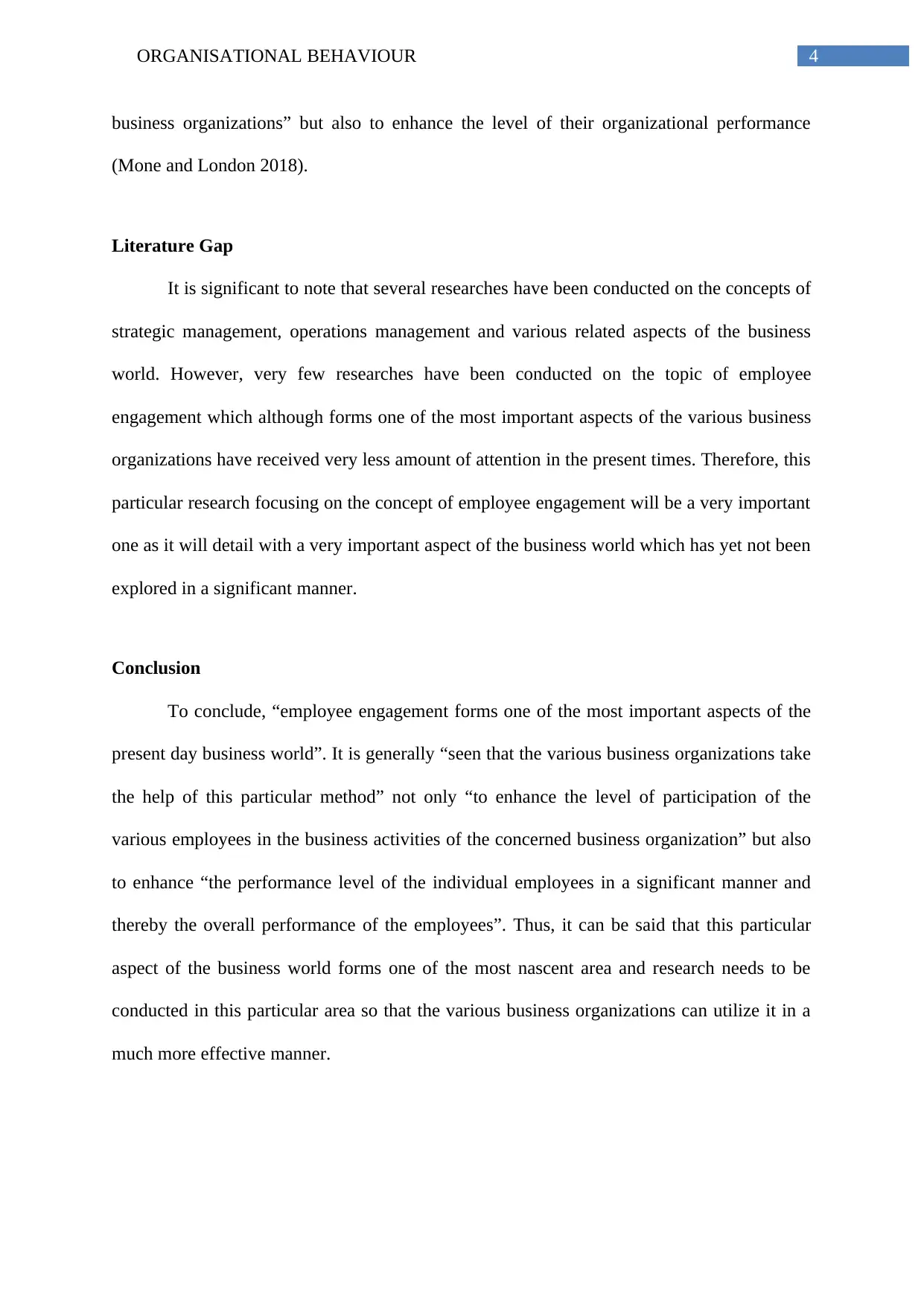
4ORGANISATIONAL BEHAVIOUR
business organizations” but also to enhance the level of their organizational performance
(Mone and London 2018).
Literature Gap
It is significant to note that several researches have been conducted on the concepts of
strategic management, operations management and various related aspects of the business
world. However, very few researches have been conducted on the topic of employee
engagement which although forms one of the most important aspects of the various business
organizations have received very less amount of attention in the present times. Therefore, this
particular research focusing on the concept of employee engagement will be a very important
one as it will detail with a very important aspect of the business world which has yet not been
explored in a significant manner.
Conclusion
To conclude, “employee engagement forms one of the most important aspects of the
present day business world”. It is generally “seen that the various business organizations take
the help of this particular method” not only “to enhance the level of participation of the
various employees in the business activities of the concerned business organization” but also
to enhance “the performance level of the individual employees in a significant manner and
thereby the overall performance of the employees”. Thus, it can be said that this particular
aspect of the business world forms one of the most nascent area and research needs to be
conducted in this particular area so that the various business organizations can utilize it in a
much more effective manner.
business organizations” but also to enhance the level of their organizational performance
(Mone and London 2018).
Literature Gap
It is significant to note that several researches have been conducted on the concepts of
strategic management, operations management and various related aspects of the business
world. However, very few researches have been conducted on the topic of employee
engagement which although forms one of the most important aspects of the various business
organizations have received very less amount of attention in the present times. Therefore, this
particular research focusing on the concept of employee engagement will be a very important
one as it will detail with a very important aspect of the business world which has yet not been
explored in a significant manner.
Conclusion
To conclude, “employee engagement forms one of the most important aspects of the
present day business world”. It is generally “seen that the various business organizations take
the help of this particular method” not only “to enhance the level of participation of the
various employees in the business activities of the concerned business organization” but also
to enhance “the performance level of the individual employees in a significant manner and
thereby the overall performance of the employees”. Thus, it can be said that this particular
aspect of the business world forms one of the most nascent area and research needs to be
conducted in this particular area so that the various business organizations can utilize it in a
much more effective manner.
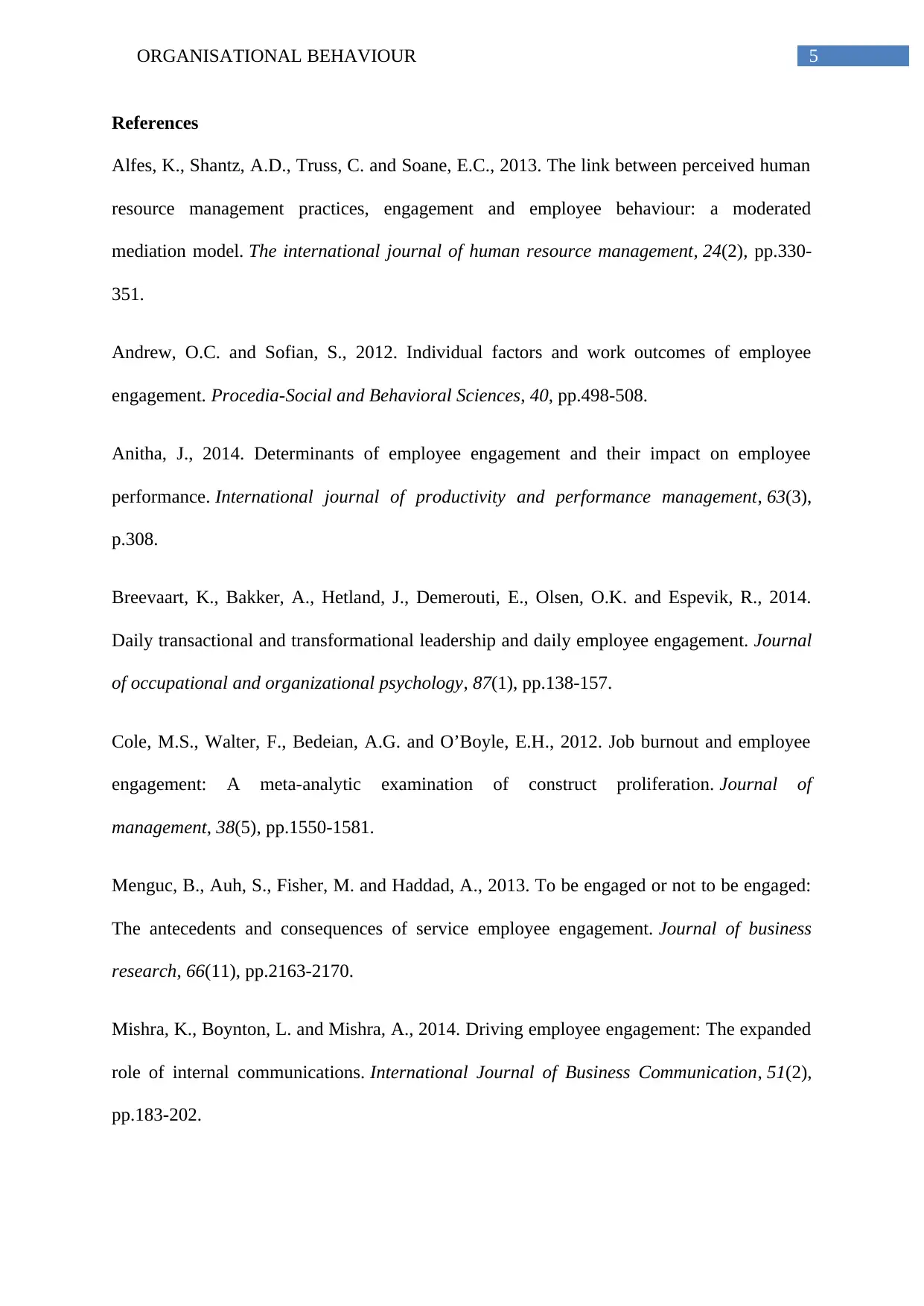
5ORGANISATIONAL BEHAVIOUR
References
Alfes, K., Shantz, A.D., Truss, C. and Soane, E.C., 2013. The link between perceived human
resource management practices, engagement and employee behaviour: a moderated
mediation model. The international journal of human resource management, 24(2), pp.330-
351.
Andrew, O.C. and Sofian, S., 2012. Individual factors and work outcomes of employee
engagement. Procedia-Social and Behavioral Sciences, 40, pp.498-508.
Anitha, J., 2014. Determinants of employee engagement and their impact on employee
performance. International journal of productivity and performance management, 63(3),
p.308.
Breevaart, K., Bakker, A., Hetland, J., Demerouti, E., Olsen, O.K. and Espevik, R., 2014.
Daily transactional and transformational leadership and daily employee engagement. Journal
of occupational and organizational psychology, 87(1), pp.138-157.
Cole, M.S., Walter, F., Bedeian, A.G. and O’Boyle, E.H., 2012. Job burnout and employee
engagement: A meta-analytic examination of construct proliferation. Journal of
management, 38(5), pp.1550-1581.
Menguc, B., Auh, S., Fisher, M. and Haddad, A., 2013. To be engaged or not to be engaged:
The antecedents and consequences of service employee engagement. Journal of business
research, 66(11), pp.2163-2170.
Mishra, K., Boynton, L. and Mishra, A., 2014. Driving employee engagement: The expanded
role of internal communications. International Journal of Business Communication, 51(2),
pp.183-202.
References
Alfes, K., Shantz, A.D., Truss, C. and Soane, E.C., 2013. The link between perceived human
resource management practices, engagement and employee behaviour: a moderated
mediation model. The international journal of human resource management, 24(2), pp.330-
351.
Andrew, O.C. and Sofian, S., 2012. Individual factors and work outcomes of employee
engagement. Procedia-Social and Behavioral Sciences, 40, pp.498-508.
Anitha, J., 2014. Determinants of employee engagement and their impact on employee
performance. International journal of productivity and performance management, 63(3),
p.308.
Breevaart, K., Bakker, A., Hetland, J., Demerouti, E., Olsen, O.K. and Espevik, R., 2014.
Daily transactional and transformational leadership and daily employee engagement. Journal
of occupational and organizational psychology, 87(1), pp.138-157.
Cole, M.S., Walter, F., Bedeian, A.G. and O’Boyle, E.H., 2012. Job burnout and employee
engagement: A meta-analytic examination of construct proliferation. Journal of
management, 38(5), pp.1550-1581.
Menguc, B., Auh, S., Fisher, M. and Haddad, A., 2013. To be engaged or not to be engaged:
The antecedents and consequences of service employee engagement. Journal of business
research, 66(11), pp.2163-2170.
Mishra, K., Boynton, L. and Mishra, A., 2014. Driving employee engagement: The expanded
role of internal communications. International Journal of Business Communication, 51(2),
pp.183-202.
⊘ This is a preview!⊘
Do you want full access?
Subscribe today to unlock all pages.

Trusted by 1+ million students worldwide
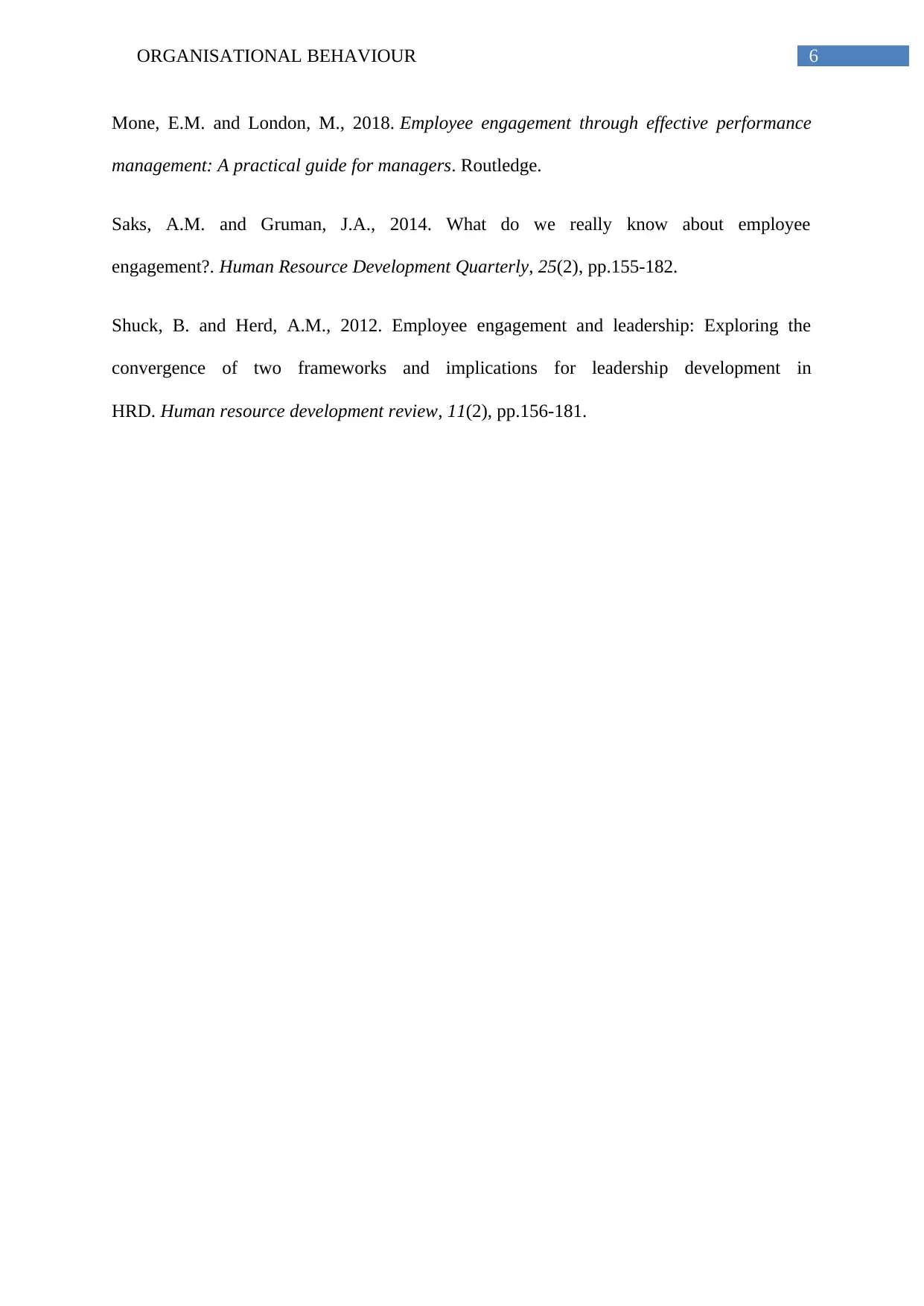
6ORGANISATIONAL BEHAVIOUR
Mone, E.M. and London, M., 2018. Employee engagement through effective performance
management: A practical guide for managers. Routledge.
Saks, A.M. and Gruman, J.A., 2014. What do we really know about employee
engagement?. Human Resource Development Quarterly, 25(2), pp.155-182.
Shuck, B. and Herd, A.M., 2012. Employee engagement and leadership: Exploring the
convergence of two frameworks and implications for leadership development in
HRD. Human resource development review, 11(2), pp.156-181.
Mone, E.M. and London, M., 2018. Employee engagement through effective performance
management: A practical guide for managers. Routledge.
Saks, A.M. and Gruman, J.A., 2014. What do we really know about employee
engagement?. Human Resource Development Quarterly, 25(2), pp.155-182.
Shuck, B. and Herd, A.M., 2012. Employee engagement and leadership: Exploring the
convergence of two frameworks and implications for leadership development in
HRD. Human resource development review, 11(2), pp.156-181.
1 out of 7
Related Documents
Your All-in-One AI-Powered Toolkit for Academic Success.
+13062052269
info@desklib.com
Available 24*7 on WhatsApp / Email
![[object Object]](/_next/static/media/star-bottom.7253800d.svg)
Unlock your academic potential
Copyright © 2020–2025 A2Z Services. All Rights Reserved. Developed and managed by ZUCOL.





